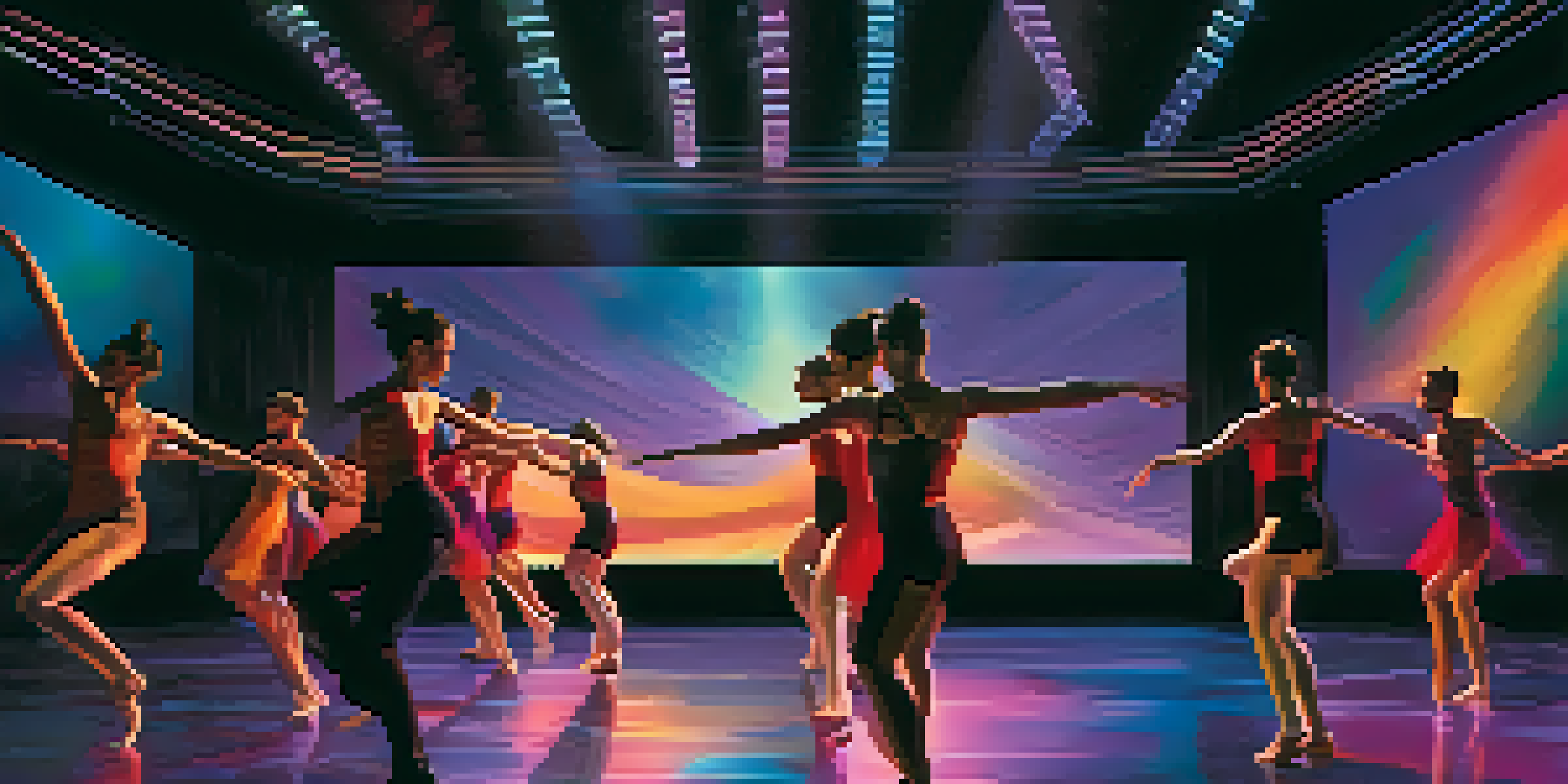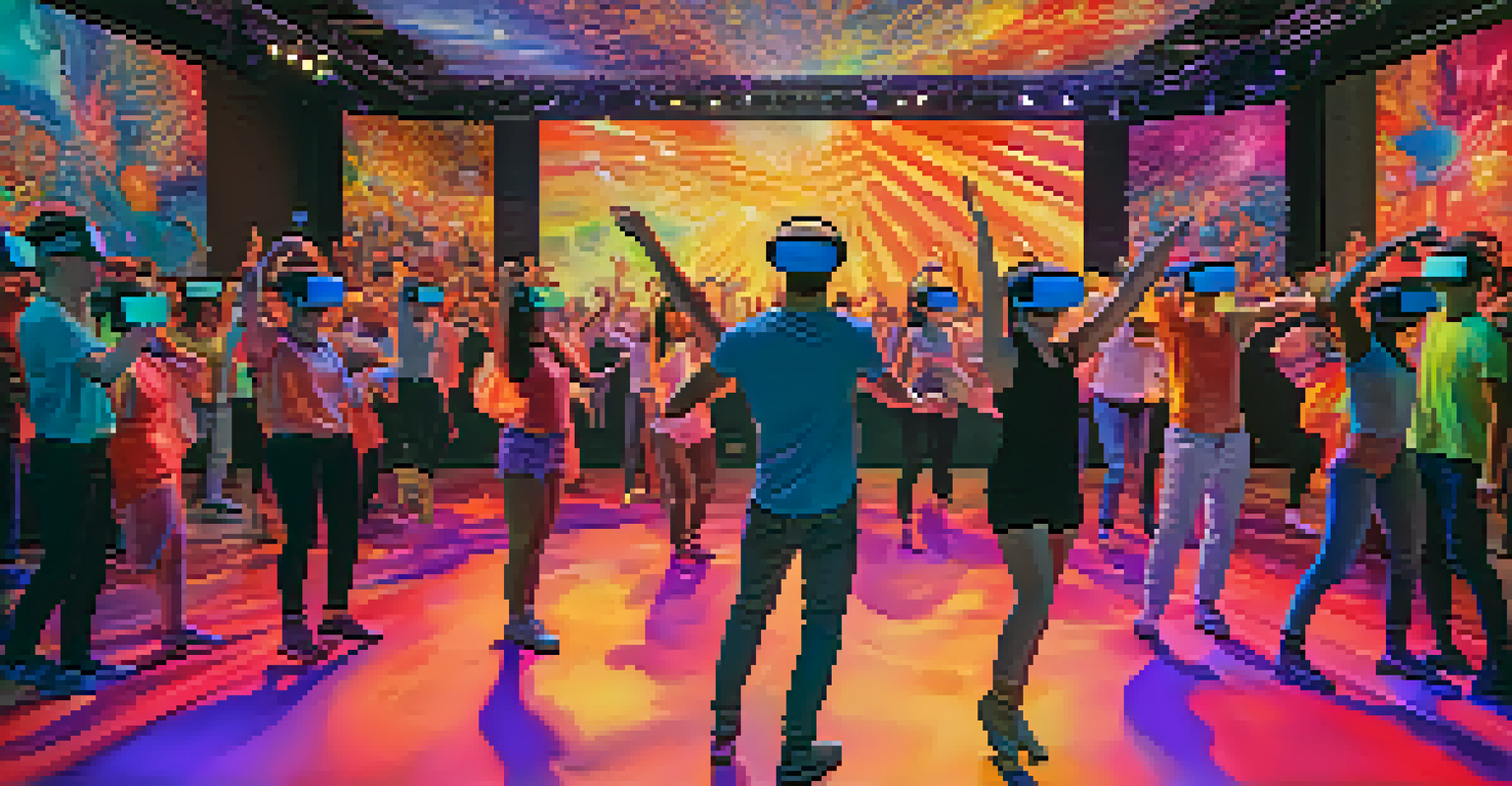Dance and Technology: Creating Immersive Performance Art

The Intersection of Dance and Technology in Performance Art
Dance and technology have found a beautiful synergy, transforming how we experience performance art. This intersection allows artists to explore new creative avenues, blending traditional movement with innovative tech tools. For example, dancers can now incorporate augmented reality (AR) to add layers of visual storytelling that enhance their choreography.
Technology is best when it brings people together.
As audiences become more tech-savvy, they expect modern performances to reflect contemporary culture, often driven by digital innovation. This expectation pushes choreographers to think outside the box, utilizing soundscapes and projections to create immersive environments. Such integration not only elevates the dance itself but also invites the audience to engage in unique ways.
Moreover, technology serves as a platform for collaboration, enabling artists from various disciplines to come together. Dancers can partner with coders, designers, and musicians, resulting in richly layered performances that captivate viewers on multiple sensory levels. This collaborative spirit is reshaping the landscape of performance art, making it more dynamic and inclusive.
How Virtual Reality is Revolutionizing Dance Experiences
Virtual reality (VR) is one of the most exciting advancements in the world of dance. It allows audiences to step into a digital realm where they can experience performances from the dancer's perspective. Imagine watching a dance piece while feeling as though you are part of the performance, surrounded by the dancers in a virtual space.

This immersive experience not only enhances engagement but also expands accessibility for those who may not be able to attend live shows. People from different locations can participate in a shared experience, breaking down geographical barriers. Thus, VR is not just a tool for entertainment; it’s a way to democratize the art of dance.
Dance Meets Technology's Innovation
The integration of technology, like AR and VR, enhances dance performances, allowing for immersive experiences and creative storytelling.
Furthermore, VR can serve as a training tool for dancers, enabling them to practice in a simulated environment. This can help hone their skills and creativity, allowing for experimentation without the constraints of a physical stage. By using VR, dancers can visualize their movements in real-time, making adjustments that improve their performance.
The Role of Wearable Technology in Dance
Wearable technology is changing the way dancers connect with their art and audience. Devices like motion sensors and smart fabrics can track a dancer's movements and provide real-time feedback. This not only enhances their performance but also contributes to the overall artistic expression by integrating data into the choreography.
Dance is the hidden language of the soul.
For instance, some dancers wear sensors that translate their movements into visual effects or sound, creating a dynamic interplay between physicality and technology. This fusion allows for spontaneous creativity, as the dance can adapt based on the data collected during the performance. It’s a dance that literally responds to the dancer’s movements.
Additionally, wearable tech can help monitor physical health, providing insights into a dancer’s performance and well-being. This is crucial in a demanding field where injuries are common. By utilizing technology to track their health, dancers can optimize their training and extend their careers.
Choreography in the Digital Age: New Possibilities
Choreography has evolved significantly with the advent of digital tools, allowing for greater experimentation and creativity. Dancers can now use software to visualize their routines, mapping out movements and formations before stepping onto the stage. This technology not only aids in planning but also encourages collaboration among choreographers and dancers.
Digital platforms enable choreographers to share their work with a global audience, reaching people beyond the confines of traditional venues. Online collaborations can lead to innovative projects that combine the talents of artists from different backgrounds and locations. This shift to a digital space fosters a sense of community among creators.
Audience Engagement Reimagined
Technology enables interactive experiences that transform audiences from passive observers to active participants in performances.
Moreover, the use of digital media in choreography opens up new narrative possibilities. Dancers can incorporate multimedia elements that interact with their movements, providing deeper context and meaning. This integration allows for storytelling that resonates on multiple levels, enhancing the emotional impact of the performance.
Audience Engagement: The New Frontier of Performance Art
Engaging the audience has always been a vital part of performance art, and technology is redefining how this can be achieved. Artists are now creating interactive experiences where audience members can influence the performance in real-time. This shift transforms passive spectators into active participants, enhancing their connection to the art.
For example, mobile apps can allow audiences to vote on certain elements of the performance, such as music or lighting, creating a unique experience for every show. This level of interactivity not only keeps audiences engaged but also fosters a sense of community and shared experience. People leave feeling as though they’ve had a hand in creating the art.
Additionally, social media platforms have become powerful tools for audience engagement before, during, and after performances. Artists can share behind-the-scenes content, host Q&A sessions, and create conversations around their work, building a loyal following. This ongoing dialogue helps to deepen the audience's investment in the performance, making each event more memorable.
Challenges of Merging Dance and Technology
While the fusion of dance and technology offers exciting opportunities, it also presents its own set of challenges. One significant hurdle is the need for technical expertise, which many dancers may not possess. Learning to operate complex software or hardware can be daunting, potentially limiting the creative process.
Moreover, the rapid pace of technological advancements can leave artists feeling overwhelmed. Keeping up with the latest tools and trends requires time and resources, which can be a barrier for many. Dancers and choreographers must find a balance between embracing new technology and maintaining their artistic integrity.
Challenges in Dance-Tech Fusion
While merging dance and technology offers exciting possibilities, it also presents challenges such as the need for technical skills and maintaining artistic integrity.
Lastly, there’s the risk that technology could overshadow the dance itself, diluting the raw emotional power that performance art can convey. It's essential for artists to remember that technology is a tool to enhance their work, not replace the fundamental connection between dancer and audience. Striking this balance is crucial for creating truly immersive performances.
The Future of Dance and Technology: A Creative Evolution
As technology continues to evolve, the future of dance and performance art looks incredibly promising. We can expect to see even more innovative uses of AI, VR, and other technologies that push the boundaries of creativity. Imagine a time when AI could assist in choreographing dance, analyzing movement patterns, or even creating entirely new styles based on data from various performances.
Additionally, advancements in virtual reality and augmented reality could lead to fully immersive environments, where audiences can experience dance in ways we’ve only dreamed of. This could mean performances that blend physical and digital spaces seamlessly, creating a multi-dimensional experience that engages all senses. The possibilities are truly limitless.

Ultimately, the fusion of dance and technology represents a creative evolution that honors tradition while embracing the future. As artists continue to explore this dynamic relationship, we can look forward to performances that inspire, challenge, and connect us in ways we never thought possible. The stage is set for a vibrant future in the world of dance.